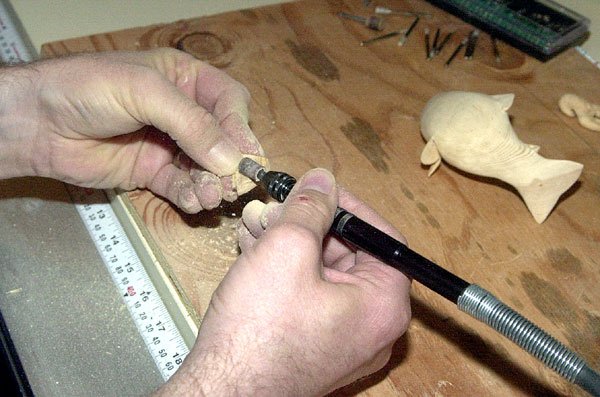GILROY
– Outside the Sowles’ family home is an average tool shed, but
to John Sowles it is a place where he can bring his unique hobby to
life.
GILROY – Outside the Sowles’ family home is an average tool shed, but to John Sowles it is a place where he can bring his unique hobby to life.
Sowles has a talent for carving wood replicas of real life fish. He says he loves recreational fishing but got started carving in 2000 because his wife wanted a fish wall hanging for their living room.
Today, friends visiting the Sowles home will notice a sea full of rainbow-colored saltwater fish carvings displayed all over the walls.
He says he comes from a family skilled in carving, constructing and woodwork. His father and grandfather were craftsmen, and when Sowles was younger he helped his father construct their family home.
Many of the bookshelves and cabinets in his home today were constructed by Sowles.
During the day he works as a beta trial manager at Nortel Networks in Santa Clara. He works developing Web sites at the company. His wife and daughter say when he comes home he spends his time in the shed perfecting his art.
“The hobby is not very expensive,” Sowles said. “I would say I only spent about $20 on each fish.”
He says he likes to use natural resources, and when he takes family trips he finds big wood logs and unique redwoods to carve on but says most carvers prefer to use basswood or tupelo wood, good fine-grain carving woods.
“I found a great piece of redwood that I am using for my current carving that will be a gift to my friend,” Sowles said.
For someone wanting to start this craft, Sowles said the best tools to use are belt sanders and rotary tools, but 80 percent of the process goes toward sanding it into shape.
Once the sanding is complete, the carvings are painted and brought to life with acrylics, lacquer and airbrush. Sowles uses a tiny brush to replicate the exact colors of the fish. He says most carvers use artificial eyes, but he chooses to paint his on.
Sowles wife, Leah, noticed how much time and effort was going into his carvings and wanted to send him to a seminar in California. Instead, she entered him in the 2003 world taxidermy and fish carving championships.
“I paid the $115 registrations fee and gave it to him as a Christmas present,” Leah Sowles said.
This year’s competition took place April 8 to 12 at the Crown Plaza Hotel and Convention Center in Springfield, Ill. Competitors from all over the world submit their carvings to compete in three different carving categories, ranging from beginner to intermediate levels.
Sowles realized he had a successful talent when his life-size decorative wall hanging, modeled after a freshwater northern pike, walked away with first-place in the Novice category.
“My eyes popped out of my head when I saw that my fish had been given the first-place ribbon, and this was my first competition,” Sowles said.
According to fish carving guidelines, judges for the three categories base their decision on craftsmanship, accuracy, essence of the species and artistry.
Many of the carvings can have plastic pieces, rocks, metal and real driftwood, but those strictly made of wood will have advantage over the others.
“The judge said the reason my carving of the freshwater northern pike won was because of its sanded shape and the detail I put into painting the body, and the eye,” Sowles said.
He says his northern pike took him about 60 hours to make and was one of the only ones featured from that species of fish at the competition.
A large portion of carving is making sure that it represents a true-to-life fish. Most competitors bring their own reference material with pictures of fish they have caught, from magazines or books, for the judges to base their final decision.
“Fish carving is so much harder than taxidermy, where you mount animals. … With carving it is such a unique art,” said Larry Blomquist, who is president of “Breakthrough Magazine”, a taxidermy journal. “You have to replicate everything from scratch. A first place in any category is an accomplishment.”
Once a carving receives a first-, second- or third-place ribbon from the three categories, it qualifies for the “best in show” title. Cash prizes up to $3,000 are awarded for carvings that receive this honor.
Sowles did not win any of the money but says it doesn’t matter because he loves doing the carvings.
The world fish carving championship is held every two years, so Sowles says he is beginning work on his entries for 2005. He hopes to bring home more ribbons or maybe win “Best in Show.”
For more information on taxidermy competitions and seminars in California go to www.taxidermynet.com.














